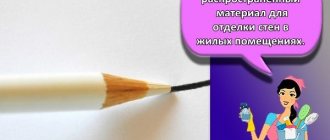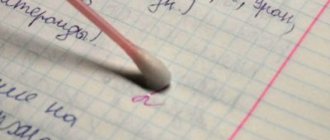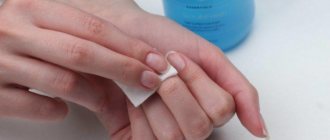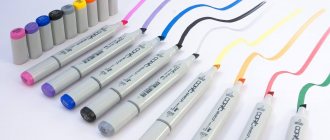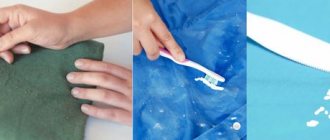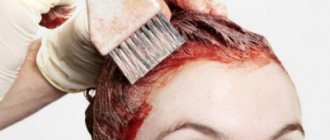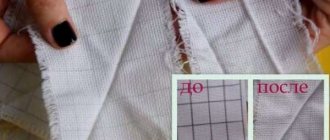How to erase a pencil or colored pencil? You can remove the drawing using the means at hand: hair elastic, crumb, tape, boiled egg
If you don’t know how to erase a pencil without an eraser - it doesn’t matter whether it’s simple or colored, if you don’t have a student’s or artistic eraser at home - you can remove the graphite mark using improvised means. The main thing is not to rub the drawing too much, otherwise a hole will appear on the paper. You can try the new eraser replacement on your draft. If it does not leave stains and erases marks well, it can be used in practice.
How to clean wallpaper from a pencil drawing
An image drawn on wallpaper with a simple pencil cannot always be erased with a student eraser. If you don’t have an eraser at home, you don’t have to buy it. It is unlikely to help get rid of the contamination caused by the graphite stylus.
It is better to buy a melamine sponge at a hardware store. It is made from compressed melamine fibers. With its help, you can clean the wallpaper not only from a pencil, but also from a pen or felt-tip pen.
The melamine sponge should not be overly wet or used entirely. You need to cut off a small piece and rub the pencil mark on the wallpaper with it.
Nag
This stationery is designed for lightening and correcting drawings made with charcoal and pastel.
It can also remove all dirt from tracing paper. This cleansing gum has a doughy texture and wrinkles easily. With a stick you can easily remove pencil marks from a sheet, while the paper remains clean, without streaks.
It is important to consider that the nag absorbs dust very quickly. It should be stored in cellophane. If necessary, the top dirty layer can be cut off and the eraser will be like new again.
At home, there are several alternative options for replacing an eraser. Each method has its own advantages and disadvantages, so you should choose based on the desired result.
How to properly erase a drawing made with a pencil
If you use something at hand instead of a student eraser, you can make stains on the paper sheet. It’s better to do a test first: try rubbing the image on a draft and look at the result. If the chosen product does not smear graphite, does not leave stains or dirt, then you can use it on the finishing surface.
You need to erase the drawing starting not from the middle, but from the very edge. It is not recommended to put pressure on the tool at hand. You need to act carefully so as not to damage the paper. Every 5 seconds you need to stop and check the result. It is not recommended to increase pressure or speed up the process. Doing so may cause the paper to tear or have a hole in it.
If the work is not urgent, you can correct the error later. It is advisable to buy a student eraser at the store and use it to erase the pencil drawing. You can ask your neighbors who have school-age children for a rubber band.
When using a means at hand, it is not always possible to do the job cleanly and remove the pencil mark without stains. It's better to take your time and wait a while. If you need to erase the line as quickly as possible, then it is advisable to use the most gentle means at hand.
Corrector
Office proofreader can be produced in liquid and dry form. With its help, you can carefully cover up errors in the text, and make the necessary corrections on a light matte surface.
The liquid in the bottle allows you to correct minor flaws in the text or even cover up entire lines. Of course, such changes will be quite noticeable, but in some situations there are no other solutions.
For spot corrections, it is best to use a corrector pen. It does not leave unpleasant streaks and blots. It can be used for all types of paper, including fax paper.
How to Remove Crayon Marks from Clothes
Don't worry if your clothes get stained with crayons! Using the methods below, you will clean your clothes quite quickly.
Removing pencil marks:
- Rub the pencil marks with cooking oil. Wash your clothes as you usually do.
- Soak the pencil-stained area of clothing with undiluted vinegar. And use a toothbrush to erase all traces of lead. Wash your clothes as you usually do.
- Spray the back of the pencil-stained area of clothing with WD-40 All-Purpose Lubricant. Or moisten with paint thinner. Leave the stain to soak for a few minutes.
- Spray the front of the pencil-stained area of clothing with WD-40 All-Purpose Lubricant. Or moisten with paint thinner.
- Apply a little dishwashing liquid to the front of the pencil-stained area of clothing. And rub it into the fabric using your fingers or a toothbrush.
- Cover the treated clothing stain on both sides with paper towels (napkins). The paper will absorb the dirty stain and clean the clothes.
- Wash your clothes as you usually do, preferably in hot water (if the fabric allows).
What to replace the eraser with?
It would seem, why look for a replacement for an eraser if it is always at hand and ready to be used for any task within its capabilities? Even if your favorite assistant is suddenly worn down to the ground or crumbles, it’s enough just to go to the store and buy a new one, why reinvent a wheel that was invented a long time ago? And yet, no one is immune from unforeseen situations, and sometimes the frantic question of what to replace the eraser with takes you by surprise and completely deprives you of common sense. Most often, this situation can arise at an inopportune time or in an unusual place, where your favorite household items are simply not at hand. Also, sometimes a non-standard solution has to be made due to the fact that ordinary erasers cannot cope with their duties.
How to replace the eraser if necessary?
The eraser has not always existed, but the pencil has been used for a long time, but in ancient times, people also somehow coped with mistakes? Before the advent of rubber erasers, the usual crumb of dry black bread without a crust was used to erase the lines of a graphite pencil. And this simple solution helped for many centuries, until travelers and discoverers brought rubber. Rubber did not immediately become available to the general population, and the use of the eraser we are familiar with dates back only a few decades.
And if in ancient times bread crumb was almost the only means, now you can try to use other methods, it all depends on the density of the paper and on what the text or drawing was applied with. If the paper density is high, the option of removing text or images with a razor blade or a stationery knife will probably suit you when you need to remove a large area. Or with a needle, if the area with the unwanted inscription is small. If there are no razors or stationery knives in the house, you can use soft plastic materials, for example, silicone attachments for fishing rods or other rubber objects.
When are substitutes better than the original?
You may ask how it can be that an eraser cannot cope with its direct duties, since it was specially invented for erasing pencils. If the paper is not coated and the pencil is very soft, numerous corrections can cause irreparable damage to the drawing, drawing or text. And as a result, there is a great risk of bringing a work for inspection that is full of holes and scuffs. This usually happens if paper and pencils are chosen incorrectly, an eraser is chosen poorly, and also when erasing carelessly and repeatedly. In advanced cases, replacing pencils or erasers will no longer solve the problem, and the question - what to replace the eraser with, changes to a frantic search for a solution, how to fix all this? Here the ancient method of using bread comes to the rescue, which can sometimes significantly mitigate the consequences of barbaric handling of paper, and this will indeed sometimes be better than continuing to frantically work with an eraser.
How to remove marker from linoleum?
Of course, the easiest way to wipe off linoleum is with fresh paint. In this case, a regular solution with soap or powder can help. If you have any difficulty, use the “wedge by wedge” rule: wipe off an alcohol-based marker with alcohol, and wipe off a fat-based marker with fat. But the longer the dirt from the felt-tip pen remains on the floor surface, the more it eats away, no matter what its composition. And then you can wash it with harsher means.
- Old stains are wiped off with white spirit, also known as Stoddard's gasoline solvent. This substance must be handled carefully; it can corrode linoleum. After cleaning, rinse the surface thoroughly with water.
- Sometimes toothpaste helps with stubborn markers. Apply it to the desired area and leave for 10-15 minutes. Then wash off with a damp cloth.
- You can also try to wipe off the dirt with hydrogen peroxide. Apply the solution to cotton wool and rub thoroughly.
Heating is an effective method
Is it possible to use something instead of vinegar and what can replace it with in recipes?
There are situations when the rubber element, due to its hardening, is difficult to remove from structural parts. You can achieve the desired result by heating the rubber with a stream of hot air using a hair dryer. When exposed to high temperatures, the material will become softer and can be pulled out of the part.
An element that is too “stiff” is softened by boiling in salted water. The technology is as follows:
- fill the container with salted water;
- let the liquid boil;
- place the rubber element in boiling water for 10 minutes;
- remove the rubber and quickly use it for its intended purpose.
This method is quite effective, but has a short-term effect. Once cooled, the rubber will become hard again.
Advantages and disadvantages of the material
All properties and consumer characteristics of eraser fabric are determined by its absolutely natural composition and the method of weaving the threads. The material has many advantages.
- The fabric does not contain dangerous additives, is created without the use of harmful chemical impregnations and is completely safe for health.
- The material is hypoallergenic and does not cause unwanted reactions or irritations.
- The 100% cotton material is highly breathable, allowing your skin to breathe freely.
- Cotton fiber has antibacterial properties, as it does not contribute to the proliferation of pathogenic microflora.
- The eraser is highly hygroscopic. Products made from this material can absorb up to 30% moisture, remaining dry to the touch.
- Thanks to the good thermoregulating properties inherent in any natural material, products made from eraser warm you up in the cold season and create a feeling of coolness in the heat.
- The fabric is very durable, retains its shape well, and almost does not shrink when washed.
It is impossible not to note some of the eraser's shortcomings arising from the structural features of the canvas. When sewing products, you need to choose the right thickness of needle and thread, otherwise you can cut through the fibers. In addition, the edges should be carefully processed, as the material crumbles a lot.
Why does rubber band wear out?
When an eraser rubs against paper, an electrostatic voltage arises, due to which graphite particles are attracted to pieces of the eraser that have the ability to adsorb (i.e., absorb substances into the surface layer). Then these particles, together with pieces of the eraser, are easily removed from the surface.
Interesting materials:
Why do you need baking soda? Why do you need life insurance? Why do you need to extinguish soda? Why should you study financial literacy? Why is VAT needed? Why is resistance needed? Why do you need a divorce certificate? Why do you need to lay wires in corrugation? Why do you need a humidifier? Why do you need to pour vinegar into the toilet?
What is made from fabric and how to care for it?
Traditionally, this lustrous, durable and relatively inexpensive fabric was used as a lining for outerwear. In addition, bed and table linen, curtains, and various decorative textiles are made from it. This hygienic and beautiful cotton material is used for sewing men's shirts, pajamas, light women's and children's clothing. The shiny bright eraser is very suitable for elegant and wear-resistant stage costumes, especially in folk style, as well as various accessories and decorations.
The rules for caring for an eraser are the same as for other cotton fabrics. It can be washed either by hand or in a machine. This textile is resistant to all washing modes, but it is better to wash dyed and printed fabrics at a temperature of no more than 40 degrees, without using bleaches. Even for bleached fabric, the first wash should be done at this temperature to avoid shrinkage. The eraser is not afraid of machine spinning and machine drying, and when drying in the fresh air it must be carefully straightened to avoid creases. You should also avoid exposing it to sunlight.
Read also: Why does food burn in a slow cooker?
Ironing of products made from this material is carried out in the “Cotton” mode. This operation must be carried out from the inside out, things should be slightly under-dried. Steaming can be used if necessary. Since the eraser absorbs moisture very well, products made from it should be kept in a dry place with good ventilation and under no circumstances should they be packaged in plastic bags.
Save money when using magic erasers
When things start to look dirty and worn out, we start thinking about new purchases. We may also purchase an expensive cleaning product that we are told is specifically designed to improve the appearance of the item.
The magic eraser has many uses. Once the dirt disappears, everything becomes new again. You will definitely find at least one way to use magic erasers in your household.
Seven daily habits of happy people
Smooth armpits without shaving: ways to remove hair using conventional products
When toothpaste is harmful to children: permissible age doses
With their help you can do the following:
- Remove scuff marks from automotive textiles, sneakers and baseboards.
- Destroy the dirt that accumulates on your computer keyboard.
- Remove nail polish from walls, floors and even carpeting.
- Get rid of insect marks on car grilles and window glass.
- Remove any remaining glue from the surfaces.
- Remove tarnish from silver and clean jewelry.
- Get rid of traces of rust on metal.
- Clean your bike.
- Wipe off sticky resin from painted surfaces and car body.
- Wash children's drawings off the walls (or give them an eraser so your child can do it).
- Give plastic toys a facelift no matter how dirty they get.
- Remove algae and bird droppings from your birdbath.
- Remove stains from microfiber upholstery.
- Refresh and clean dyed leather items.
- Wash off the ink and paint stains on your hands.
- Polish your garden furniture to a shine.
